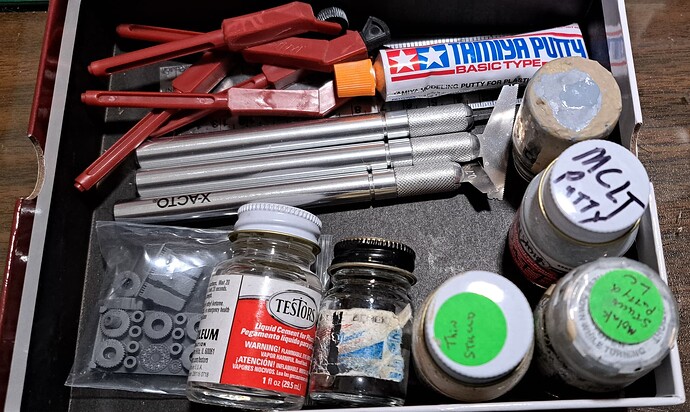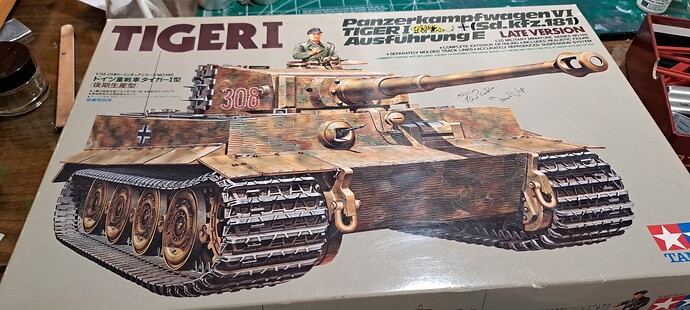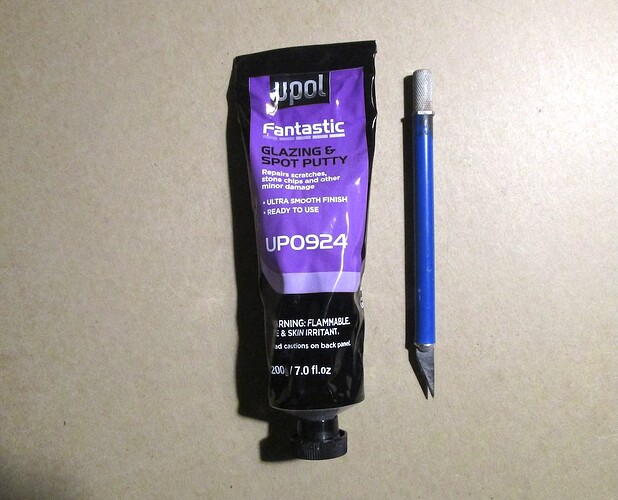White out. No sh!t.
Here’s a putty solution for you Top but it doesn’t work on large gaps. Fill the seam with Mr. Surfacer and let it dry. Then go back with a Q-Tip moistened with Mr. Color Leveling Thinner and scrub across the seam. It will remove all the excess putty and leave a smooth, flawless seam without sanding.
Thank you, Greg.
Zimmerit Coming in ~ January. I’ve packed Zimmer-kit for the road.
Molak Stucco Putty/Tamiya Basic Grey on a Tamiya Late Tiger 1.
Zimm for the Tiger build?
Yes, Otto was to buried in the closet so looks like it’s a late
Bondo , Mr. Putty the stuff in the glass jar .
Water based Perfect Putty .
In my experience, that only works some of the time. Ejector pin holes in track faces always vary in depth. Some sand or scrape out with a few swipes. Sanding to remove a slightly deeper hole usually results in a bread loaf shape because corners and edges sand down faster than the middle portion. A sanding block does not prevent this because it rolls in the hand, unlike a a machine planer. Scraping and then sanding can leave a shallow crater. Sanding further leaves a pad that is too thin. A good putty will prevent all that nonsense and produce track blocks of uniform thickness.
You know all that. This is yet another example of a small piece of advice that conceals an iceberg of know how.
…
Another thing that concerns me is the stability of various glues and fillers over time. Recently, I pulled out a 15 year old E25 for Unfinished Business 2025. While going over the project, a pea sized piece of Testors Contour Putty spontaneously popped out of the back of an idler wheel swing arm. That sort of putty shrinks as it dries. The patch mush have let go of the hole walls.
If a putty has a different coefficient of expansion than styrene, cycles of cooling and heating will eventually cause it to fracture. Variable rates of water retention could cause the same problem. Any flex in a strene part is sure to cause trouble in a patch without the same flex. Any putty that shrinks is a problem waiting to happen.
Milliput is an example of a putty that has the opposite problem. It is more durable than styrene with different material properties. My hypothesis is that styrene works free of Milliput–the reverse of what happens with other putties.
All of this supports the conclusion that leftover styrene from a model is the best patching material. Unfortunately, as I wrote earlier, drying time is a problem.
As I wrote earlier, I do not have 40+ years of plastic model building experience and must fail over and over to figure out what is really happening.
A similar product to the Bondo glazing and spot putty in the tube, mentioned above, because they are both air cure. Neither should be applied thicker than 1/8 inch (3mm) or shrinkage or noncurring center that takes 16 years to cure will occur.
The Bondo putty is more like a toothpaste consistency with some grain. The UPOL putty extrudes out of the tube like oil paint with no grain. I can apply it to fine areas with a toothpick or needle. Also can be applied to large areas with a chisel tip blade or spatula. Once cured this is not a soft putty to sand but is glassy smooth when done.
I’d fill punch marks with ground walnut shells and hide glue before using Testor’s Contour Putty. It is the very worst putty, I have EVER used. It’s course, porous and adheres like a corn starch & water slurry. Ruined several models back in the day with TCP.
If punch mark is raised on a track link, it will normally scrap clean, that’s usually OK.
If it’s recessed, use water thin CA, fill punch mark level or slightly more than level then apply a brush application of accelerator close to the CA. Let it cure and sand in a few minutes. If you can get the punch mark level with thin CA there less sanding.
Paint filled punch mark with a very think coat of thinned Molak Stucco Putty to check that punch mark is filled properly.
The process is time intensive.
I’ve wondered how well UV cure putty would work but haven’t experimented.
I’m a contractor and use fast and final AKA vinyl wall patch for filling nail holes etc in drywall and plaster. I also use it in dioramas as a filler and mortar. Recently I decided to try Vallejo plastic putty for filling joints etc. Boy am I disappointed, it’s just fast and final. Back to squadron putty for me. I’m no Rembrandt, putty perfection straight from a wet brush isn’t my forte. Besides I have yet to figure out how the wet brush works, even a damp brush washes this stuff right out of the joint after 20 seconds any putty where I don’t want it is impervious to water while the tiny joint washes out. And it sands like wet skin.


